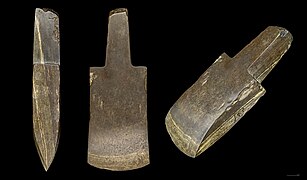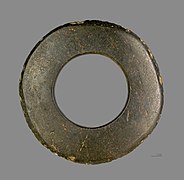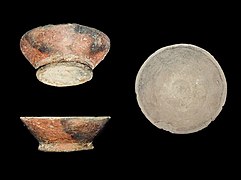Samrong Sen
Kampong Chhnang Province, Cambodia | |
| Coordinates | 12°13′0″N 104°47′0″E / 12.21667°N 104.78333°E |
|---|---|
Samrong Sen (alternates: Somron-Seng, Somrong Seng, Somrong Sen, Som-Ron-Sen;
Excavations at Samrong Sen, which started in the 1880s, have been described as the earliest prehistoric archaeological studies which gave credence to the concept of
History
Though various spellings have been presented, "Samrong Sen" is considered to be correct. The site was first discovered and reported in 1876 by M. Rouques, Director of the Fluvial Transportation Company.
- Initial villager excavations
Initial finds at Samrong Sen were by villagers' excavations while extracting for
- 19th century
The earliest artefacts were found by Lieutenant Jean Moura in 1876; he was the Representative of the
- 20th century
Systematic excavations with stratigraphic control started in 1902, and again in 1923 by Mansuy. Three layers were identified, which revealed shell lenses up to 4.5 metres (15 ft) depth. Arm bands and beads found here have similarity with those found in the Mekong sites. Pottery found here was not of any decorative type. Graves, however, gave many finds of fully formed bronze vessels.[7] Excavations carried out in stratified layers have unearthed late Stone Age ceramics and also human remains, out of which many layers are dated 2000 BC, as per radiocarbon dating methods.[10] However, the bronze collections were not found from excavations carried out in stratified layers.[2][10] Several observations[15] were made on the claims of archaeologists during the early stages of the excavations such as they were overzealous and that they over stated when presenting their findings.[15]
Prior to the World War II, the site was again excavated by Janse. He collected many artefacts, which were examined in 1986 by Robert E. Murowchick of
Finds of Mansuy were further examined by French archaeologists in 1998 for human skeletons. This study identified three fully preserved skulls. In addition, 20 mandibles and several post-cranial ones found here established that these belonged to at least 20 people.[18] Also found was a bronze mould and various arrowheads, axeheads, chisels and fish hooks etc.[19]
Geography
Samrong Sen is located in central Cambodia on the east bank of the Stueng
The Samrong Sen village, where the archaeological site is situated, is in the
Fauna
Excavations uncovered bones of faunal species (cattle, pig, dog) and aqua species (
Findings
Morphological characteristics of the tools have been the basis for the categorization of the Samrong Sen stone tools. The adzes, axes, shouldered adzes, shouldered axes, gouges, chisels, a burnisher, a tool used as a hammer are the eight identified categories. The most common tools found were adzes, followed by chisels and gouges. Axes and shouldered axes were very few. In the early excavation stages, flakes, debris, pre-forms and unfinished tools were not part of the collections. Further, though tool-manufacturing techniques could not be correctly discerned, it has been inferred after careful study of the tools that picking or flaking was the initial step followed by partial, edge, and full grinding. It has also been conjectured that sawing techniques were used.[2]
The adzes have quadrangular sections similar to those found in
Other observations showed that the ceramics contained decoration that are incised or impressed, a stylish technology which could exist at other locations; an earthenware vase mounted on a pedestal (reported by Mansuy in 1902 and in Mourer in 1971) attests to the polished stone adzes of the late Neolithic or early Bronze Age and are found in the adjoining countries of Thailand and Vietnam; stylistic changes have been recorded in the stratigraphic sequences such as in the curvilinear geometric ware.[22] With findings of bronzes, arrow heads, hooks, bracelets, an axe, and a sandstone mould for axes, the excavations have also bridged the information gap between the Bronze Age with the excavations done at Angkor Borei.[23] The Bronze Age manufacturing of bronze finds at Samrong Sen and other sites in Cambodia are inferred to have been the outcome of supplies of ingots of copper received from central or northeastern Thailand, as Cambodia lacked any copper resources in its own territory. The finished bronze products produced in Cambodia are, however, testified by the large quantity of moulds and workshop remnants found during excavations.[10] It was also revealed that the settlers of Samrong Sen lived in bamboo houses on stilts, much like today[24]
-
Chisel – former collection of Jean MouraMHNT
-
Shouldered axes – former collection of Jean MouraMHNT
-
Shouldered axes – former collection of Jean MouraMHNT
-
Ear stretching plug – former collection of Jean MouraMHNT
-
Jade ornaments – former collection of Jean MouraMHNT
-
Necklace – former collection of Jean MouraMHNT
-
Necklace – former collection of Jean MouraMHNT
-
Ceramic bowl decorated – former collection of Jean MouraMHNT
-
Ceramic vase – former collection of Jean MouraMHNT
Collections
The 1864 Moura collection of 18 items is housed in the
References
- ^ a b Sophady (2007), p. 7
- ^ ISSN 1824-2707. Retrieved 15 January 2011.
- ISBN 978-1-4223-1779-2. Retrieved 20 January 2011.
- ISBN 978-0-8133-4363-1. Retrieved 21 January 2011.
- ISBN 978-0-231-11004-4. Retrieved 20 January 2011.
- ^ Miksic (2003), p. 208
- ^ ISBN 978-0-521-27525-5. Retrieved 15 January 2011.
- S2CID 163785166.
- ^ Sophady (2007), pp. 1–4
- ^ a b c d e "The First Golden Civilization of Cambodia, Unexpected Archaeological Discoveries". Memut Center for Archaeology. Retrieved 15 January 2011.
- ISBN 978-974-8434-93-3. Retrieved 20 January 2011.
- ^ a b c Sophady (2007), pp. 4–7
- ^ a b Sophady (2007), p.92
- ^ a b Dr. Sergey Lapteff (16 May 2007). "Prehistoric Culture of Cambodia and its Relationship towards South China". MIHO Museum. Retrieved 15 January 2011.
- ^ a b c d e f Higham (1996), pp. 22–23
- ISBN 978-0-415-29777-6. Retrieved 15 January 2011.
- ISBN 978-9971-69-351-0. Retrieved 18 January 2011.
- ^ Sophady (2007), p.8
- ISBN 978-1-58886-028-6. Retrieved 21 January 2011.
- ^ Demeter, Fabrice; Evelyn Peyre; Yves Coppens (2002). "The Prehistoric Human Remains of Som Ron Sen, Cambodia". Indo-Pacific Prehistory Association Bulletin 22. Laboratoire d'Anthropologie biologique, Musée de L'Homme, Paris: anu.edu.au. Retrieved 20 January 2011.
- ^ Sophady (2007), pp. 5–7
- ^ a b Miksic (2003) pp. 213–214
- ISBN 978-1-57607-770-2. Retrieved 18 January 2011.
- ISBN 978-1-903471-40-1. Retrieved 21 January 2011.
- ^ a b Higham (1996), p. 22
- ^ Sophady (2007), p. 10
Bibliography
- Higham, Charles (1996). The Bronze Age of Southeast Asia. Cambridge University Press. ISBN 978-0-521-56505-9. Retrieved 18 January 2011.
- ISBN 978-9971-69-271-1. Retrieved 18 January 2011.
- Sophady, Heng (2007). "A Study of Polished Stone Tools from Samrong Sen, Cambodia: The French Museum Collections" (PDF). Tautavel: Muséum National d'Histoire Naturelle, Paris Département de Préhistoire. Retrieved 20 January 2011.









